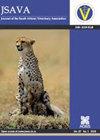化学发光法和放射免疫法测定犬生殖道孕酮含量的比较
IF 0.9
4区 农林科学
Q3 VETERINARY SCIENCES
Journal of the South African Veterinary Association
Pub Date : 2019-10-22
DOI:10.4102/jsava.v90i0.1730
引用次数: 3
摘要
长期以来,Coat-A-Count®放射免疫测定法被广泛用于测定母狗血清或血浆中的孕酮浓度(progRIA),但于2014年停用。自2003年以来,Immulite®1000 LKPG1化学发光免疫测定法在测定母狗血清中孕酮浓度方面获得了突出的地位,但该测定法在2012年发生了变化(Immulite®1000 LKPW1)。本研究评估了使用Immulite®1000 LKPW1(程序)来估计发情期间临床相关事件时间的可行性,并在黄体生成素激增(LH1)的第一天或仅一天后的第2天和第3天比较了程序和程序。在31个发情期中,28个(90%)的ProgImm首次超过5.1 nmol/L的时间与progRIA首次超过6 nmol/L的时间相同,或在发情期的前一天。在35个发情期中,有34个(97%)在ProgImm首次超过13.6 nmol/L的同一天或前一天,progRIA首次超过16 nmol/L(排卵日的一个代表)。25个发情期中有24个(95%)的发情期前1天或第1天浓度首次超过5.4 nmol/L。LH1后2天的中位数比progRIA的10.7 nmol/L低1.2 nmol/L (p = 0.001)。LH1后3 d的progRIA平均浓度比19.0 nmol/L低2.2 nmol/L (p < 0.001)。综上所述,方案首次超过5.1 nmol/L、13.6 nmol/L和5.4 nmol/L的天数可以有效估计方案达到6 nmol/L或16 nmol/L或LH1的天数。本文章由计算机程序翻译,如有差异,请以英文原文为准。
Comparison of progesterone assay by chemiluminescence or radioimmunoassay for clinical decision-making in canine reproduction
The Coat-A-Count® radioimmunoassay has been long and widely used to determine the concentration of progesterone in serum or plasma of bitches (progRIA), but was discontinued in 2014. The Immulite® 1000 LKPG1 chemiluminescence immunoassay has gained prominence since 2003 to determine the concentration of progesterone in serum of bitches, but the assay changed in 2012 (Immulite® 1000 LKPW1). This study assessed the feasibility of using Immulite® 1000 LKPW1 (progImm) to estimate the time of clinically relevant events during oestrus and compared progRIA and progImm 2 and 3 days after the first or only day of the luteinizing hormone surge (LH1). ProgImm first exceeded 5.1 nmol/L on the same day that progRIA first exceeded 6 nmol/L, a proxy for the occurrence of the LH surge, or the day before in 28 of 31 (90%) of oestrous periods. ProgImm first exceeded 13.6 nmol/L on the same day that progRIA first exceeded 16 nmol/L (a proxy for the day of ovulation) or the day before in 34 of 35 (97%) oestrous periods. ProgImm first exceeded 5.4 nmol/L on LH1 or the day before in 24 of 25 (95%) of oestrous periods. The median of progImm 2 days after LH1 was 1.2 nmol/L lower than the 10.7 nmol/L of progRIA (p = 0.001). The mean of progImm 3 days after LH1 was 2.2 nmol/L lower than the 19.0 nmol/L of progRIA (p < 0.001). In conclusion, the days on which progImm first exceeded 5.1 nmol/L, 13.6 nmol/L and 5.4 nmol/L effectively estimate the days on which progRIA reached 6 nmol/L or 16 nmol/L or LH1.
求助全文
通过发布文献求助,成功后即可免费获取论文全文。
去求助
来源期刊

Journal of the South African Veterinary Association
VETERINARY SCIENCES-
CiteScore
1.50
自引率
0.00%
发文量
23
审稿时长
22 weeks
期刊介绍:
The Journal of the South African Veterinary Association is a contemporary multi-disciplinary scientific mouthpiece for Veterinary Science in South Africa and abroad. It provides veterinarians in South Africa and elsewhere in the world with current scientific information across the full spectrum of veterinary science. Its content therefore includes reviews on various topics, clinical and non-clinical articles, research articles and short communications as well as case reports and letters.
 求助内容:
求助内容: 应助结果提醒方式:
应助结果提醒方式:


